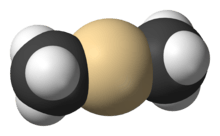Dimethylcadmium
 | |
| Identifiers | |
|---|---|
3D model (JSmol) |
|
| ChemSpider | |
| EC Number | 208-055-4 |
PubChem CID |
|
| UNII | |
| |
| |
| Properties | |
| C2H6Cd | |
| Molar mass | 142.48 g·mol−1 |
| Appearance | Colorless liquid |
| Density | 1.985 g/mL |
| Melting point | -4.5 ºC |
| Boiling point | 106 ºC |
| Hazards | |
| Main hazards | toxic |
| GHS pictograms |    |
| GHS signal word | Danger[1] |
| H225, H250, H252, H260, H301, H330, H350, H360[1] | |
| P101, P102, P103, P231, P222, P301+310, P303+361+353, P305+351+338, P403+233, P422, P501[1] | |
| NFPA 704 | |
| Flash point | -18 °C[1] |
Except where otherwise noted, data are given for materials in their standard state (at 25 °C [77 °F], 100 kPa). | |
| Infobox references | |
Dimethylcadmium is the organocadmium compound with the formula Cd(CH3)2. It is a colorless highly toxic liquid that fumes in air. It is a linear molecule with C-Cd bond lengths of 213 pm.[2] The compound finds limited use as a reagent in organic synthesis and in metalorganic chemical vapor deposition (MOCVD). It has also been used in the synthesis of cadmium selenide nanoparticles, though efforts have been made to replace it in this capacity due to its toxicity.[3]
Dimethylcadmium is prepared by treating cadmium dihalides with methyl Grignard reagents or methyllithium.[4]
- CdBr2 + 2 CH3MgBr → Cd(CH3)2 + MgBr2
The same method was used in the first preparation of this compound.[5]
Dimethylcadmium is a weak Lewis acid, forming an adduct with bipyridine and with ether.[4]
References
- 1 2 3 4 5 "Dimethylcadmium". American Elements. Retrieved 2018-08-20.
- ↑ Felix Hanke; Sarah Hindley; Anthony C. Jones; Alexander Steiner (2016). "The Solid State Structures of the High and Low Temperature Phases of Dimethylcadmium". Chemical Communications. 52: 10144–10146. doi:10.1039/c6cc05851e.
- ↑ Julia Hambrock; Alexander Birkner; Roland A. Fischer (2001). "Synthesis of CdSe nanoparticles using various organometallic cadmium precursors". Journal of Materials Chemistry. 11: 3197–3201. doi:10.1039/B104231A.
- 1 2 Douglas F. Foster; David J. Cole-Hamilton (1997). "Electronic Grade Alkyls of Group 12 and 13 Elements". Inorganic Syntheses. 31: 21–66. doi:10.1002/9780470132623.ch7.
- ↑ Erich Krause (1917). "Einfache Cadmiumdialkyle. (I. Mitteilung über organische Cadmium-Verbindungen.)". Berichte der deutschen chemischen Gesellschaft. 50 (2): 1813–1822. doi:10.1002/cber.19170500292.
This article is issued from
Wikipedia.
The text is licensed under Creative Commons - Attribution - Sharealike.
Additional terms may apply for the media files.
